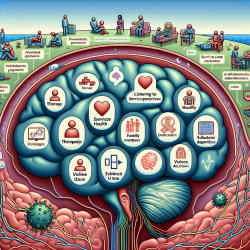Introduction
Human trafficking remains a critical issue worldwide, with countless individuals falling victim to this heinous crime. A recent study titled "Prevalence estimates of trafficking in persons using statistical definitions: a cross-sectional high-risk community survey in Cape Town, South Africa" offers valuable insights into the prevalence and detection of trafficking cases. This research, published in BMJ Open, provides practitioners with a methodological framework that can be instrumental in improving the identification and support of trafficking victims.
Understanding the Research
The study applied the Prevalence Reduction Innovation Forum (PRIF) statistical definitions to a community survey conducted in Cape Town, South Africa. By using a high-risk sampling strategy, the researchers were able to generate prevalence estimates of trafficking in persons (TIP). The results indicated a lifetime TIP prevalence rate of 17.0% and a past 12-month rate of 2.9% among the sampled population.
The research highlighted the effectiveness of two screening tools: the Trafficking Victim Identification Tool (TVIT) and the Adult Human Trafficking Screening Tool (AHTST). These tools demonstrated excellent predictive utility, suggesting their potential for broader application in global and regional TIP research and policymaking.
Implementing Research Outcomes
Practitioners can leverage the outcomes of this study to enhance their skills and strategies in combating human trafficking. Here are a few ways to implement the research findings:
- Adopt Evidence-Based Screening Tools: Incorporate the TVIT and AHTST into your practice to improve the identification of trafficking victims. These tools have shown high predictive utility and can be adapted for use in various settings.
- Engage in Continuous Education: Stay informed about the latest research and developments in human trafficking. Attend conferences, webinars, and workshops to deepen your understanding and refine your skills.
- Collaborate with Stakeholders: Work with local and international organizations to develop comprehensive strategies for addressing trafficking. Collaboration can lead to more effective interventions and support for victims.
- Advocate for Policy Change: Use research findings to advocate for policy changes that prioritize the identification and support of trafficking victims. Evidence-based advocacy can influence legislation and resource allocation.
Encouraging Further Research
While this study provides valuable insights, it also underscores the need for further research in the field of human trafficking. Practitioners are encouraged to explore the following areas:
- Standardization of Definitions: Work towards developing standardized operational definitions of TIP to facilitate consistent data collection and analysis across studies.
- Longitudinal Studies: Conduct longitudinal studies to track the long-term outcomes of trafficking victims and the effectiveness of interventions.
- Cultural and Contextual Considerations: Investigate the cultural and contextual factors that influence trafficking dynamics in different regions to tailor interventions accordingly.
Conclusion
By implementing the outcomes of this research and engaging in further study, practitioners can play a pivotal role in combating human trafficking. The insights gained from this study provide a foundation for developing more effective strategies to identify and support victims, ultimately contributing to the global effort to eradicate trafficking.
To read the original research paper, please follow this link: Prevalence estimates of trafficking in persons using statistical definitions: a cross-sectional high-risk community survey in Cape Town, South Africa.










